| |
|
Robber Fly, Bee Killer, Robber Flies, Asilidae
|
| Robber flies are strong, hairy, active, predatory flies. They're a common insect and can be spotted flying in a darting motion while preying on a wide variety of insects. As a rule, they're fairly slender, strong for their size, and equipped with a large, tapering, hard beak, which contains a sharp lancet. This weapon is thrust out creating a severe wound in the bodies of captured prey insects. A robber fly's beak tip is covered with stiff bristles, designed to secure it within the wound it creates. Robber flies have large eyes giving them good vision for spotting and seizing prey. Much like a hawk, robber flies swoop down on their prey, grasping them firmly, and then fly off to an appropriate place to devour their prize. Most victims are captured mid-flight. Nearly any flying insect is potential dinner – other flies, bees, beetles, moths, butterflies, grasshoppers, and even other robber flies. They are true cannibals. Like praying mantis, the female robber fly fequently rejects the amorous attention of a male, seizing and eating him instead! |
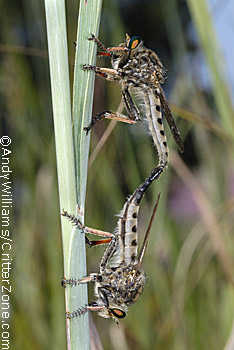 mating robber flies, Asilidae
mating robber flies, Asilidae
|
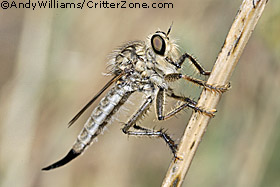 robber fly, Asilidae
robber fly, Asilidae
|
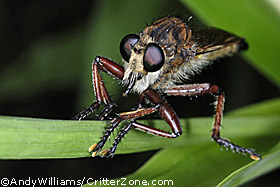 robber fly, Asilidae
robber fly, Asilidae
|
| Beekeepers have reason to fear robber flies, as they're commonly known as bee-killers. Their attack on an apiary can be serious. The robber fly captures a bee by making rapid dashes, catching it in flight, and squeezing it tightly against its own body with its strong grasp. Immediately following this, a bush, stick, or tall weed is sought, where the robberfly can slurp up its prey. Piercing a hole in the bee's body, and sucking out its soft, juicy innards is how the ugly feeding business is accomplished. Only the dry shell of what was once a bee is left behind. With careful observation robber fly feeding spots can be found. One only has to look for a pile of bee hulls lying on the ground. Somewhere above this location would be the robber fly's favored dining table. Robber fly beaks are sturdy enough to pierce human skin; but, fortunately for us, none of the little monsters have acquired a taste for us. |
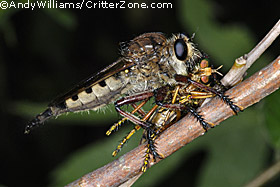 robber fly with prey, hunting, eating
robber fly with prey, hunting, eating
|
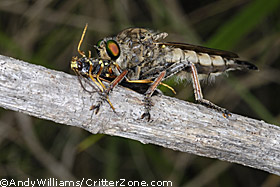 robber fly with prey, hunting, eating
robber fly with prey, hunting, eating
|
| Robber fly coloration varies, but nearly all are very hairy, or bristly. In the Asilidae family some good cases of what is called “aggressive mimicry” exist. Aggressive mimicry means that a predatory insect looks very much like its prey, camouflaging it among its dinner. The Hollywood movie "Mimic" comes to mind. In the film giant mutant cockroaches evolve to look like, or mimic, their human meals. Similar to this idea but based in reality, there exists a robber fly that looks much like the paper wasp, Polistes metricus, while some genus Mallophora robber flies closely resemble bumblebees. These robber flies have hind legs which have evolved to look very much like the pollen-bearing hind legs of bumblebees. This feature further deepens their disguise. In the genus Laphria there occurs a robberfly which closely resembles a big wasp in the genus Vespa. As you can see, there are many instances of mimicry in the robber fly family. |
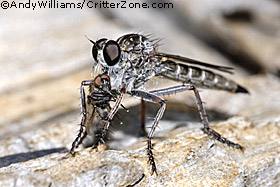 robber fly with prey, hunting, eating
robber fly with prey, hunting, eating
|
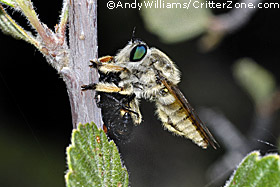 robber fly with prey, hunting, eating
robber fly with prey, hunting, eating
|
| Robber fly larvae live underground and in decaying wood where they prey upon the larvae of wood-boring beetles. In the ground they may seek out and eat buried grasshopper eggs. Their pupae bristle with spines possibly making an exit from underground or decaying logs a little easier. |
Robber flies comprise a very large group of species. Over four hundred can be found in the United States alone. Next time you're out in tall grass near the woods, keep an eye out for their erratic flight pattern. You may witness a voracious robber fly efficiently hunting down its unsuspecting victim. One can't help but be fascinated by their effectiveness as predators in the insect world.
Andy Williams / CritterZone.com |
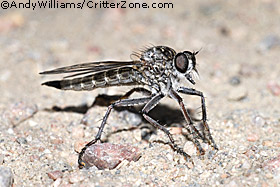 robber fly, Asilidae
robber fly, Asilidae
|
The robber fly pictures on this page are available for commercial stock photography license. All text and photos that appear on this webpage are copyrighted and may not be copied or used in any way without permission from CritterZone.
CritterZone does not specifically endorse our advertisers, or their methods. We cannot control the ads that run on our articles. CritterZone advocates humane and respectful treatment of all creatures.
Save this page:

|
|
|
|